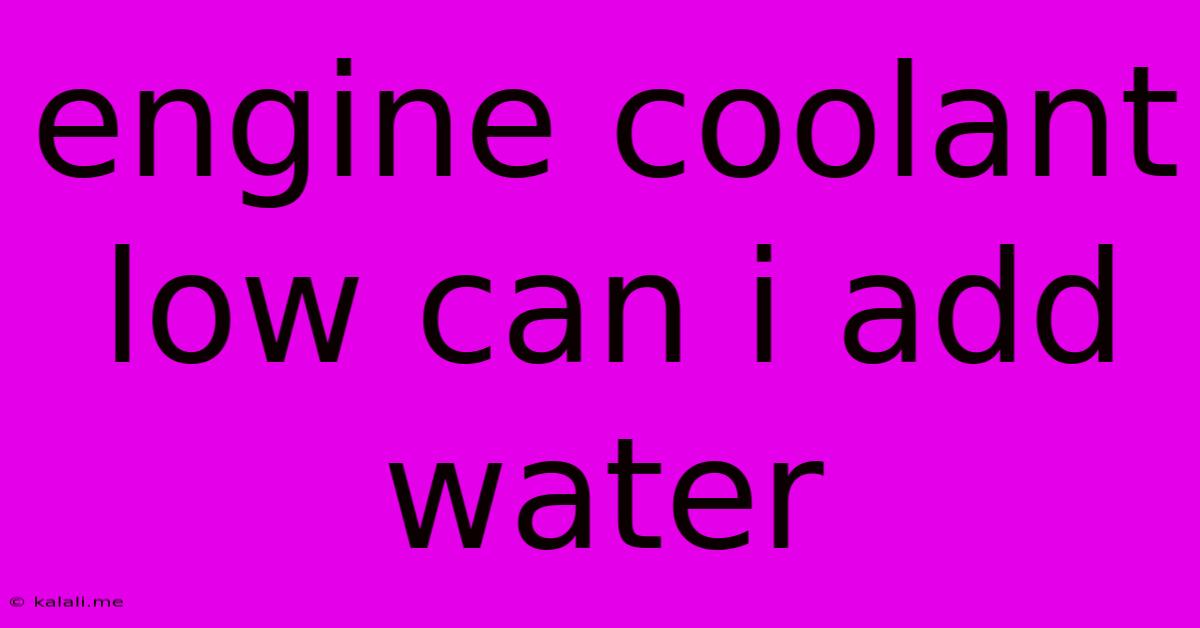Engine Coolant Low Can I Add Water
Kalali
May 20, 2025 · 4 min read

Table of Contents
Engine Coolant Low: Can I Add Water? A Comprehensive Guide
Meta Description: Is your engine coolant low? Find out if adding water is a safe solution, the risks involved, and the best practices for maintaining your vehicle's cooling system. Learn about coolant types and the importance of using the correct mixture.
Seeing that dreaded "low coolant" warning light can be alarming. Your immediate thought might be: "Can I just add water?" While seemingly a simple fix, adding plain water to your car's cooling system isn't always the best idea, and could even cause damage. This guide explains why and what you should do instead.
Understanding Your Cooling System
Your car's cooling system is crucial for preventing overheating, which can lead to serious engine damage. It's a complex system involving the engine block, radiator, water pump, thermostat, hoses, and coolant. The coolant, a mixture of water and antifreeze (or engine coolant), is vital for:
- Heat Transfer: Absorbing heat from the engine and transferring it to the radiator for dissipation.
- Corrosion Prevention: Protecting engine components from rust and corrosion.
- Freezing Protection: Preventing the coolant from freezing in cold weather, which could crack engine components.
- Boiling Point Elevation: Raising the boiling point of the water, preventing overheating.
Why Not Just Add Water?
While water can temporarily cool the engine, adding only water to a low coolant system is generally not recommended. Here's why:
- Corrosion: Plain water lacks the corrosion inhibitors found in antifreeze. This can lead to rust and scaling inside your engine block and radiator, reducing their lifespan and potentially causing costly repairs.
- Freezing: In colder climates, water alone can freeze, expanding and potentially cracking engine blocks, radiator hoses, and other vital components. This damage can be extremely expensive to repair.
- Reduced Efficiency: Water alone doesn't have the same heat transfer capabilities as a properly mixed coolant solution. This can reduce the efficiency of your cooling system, increasing the risk of overheating.
- Voiding Warranty: Adding the wrong substance to your cooling system might void your car's warranty, leaving you responsible for expensive repairs.
What To Do When Your Coolant Is Low
The best course of action when your coolant is low depends on several factors, including the severity of the leak, the ambient temperature, and the type of coolant your vehicle requires. However, here's a general approach:
-
Identify the Leak (If Possible): Carefully inspect your engine bay for visible leaks. Look for wet spots, dripping coolant, or damaged hoses. If you find a significant leak, do not drive the car. Get it towed to a mechanic immediately.
-
Check Your Owner's Manual: Consult your owner's manual to determine the correct type of coolant for your vehicle. Different vehicles may require different types, and using the incorrect one can cause problems.
-
Add the Correct Coolant (If Safe): If the leak appears minor and you have the correct coolant on hand, add a small amount to the coolant reservoir, keeping an eye on the level. Never remove the radiator cap while the engine is hot, as this can lead to severe burns.
-
Monitor the Coolant Level: After adding coolant, monitor the level regularly. If the level continues to drop, you have a leak that needs professional attention.
-
Schedule Professional Service: If you are unsure about any aspect of your cooling system, or if the coolant level continues to drop, take your car to a qualified mechanic for inspection and repair.
Choosing the Right Coolant
Coolant types are generally categorized as either conventional (typically green) or extended life (typically orange, yellow, or pink). Using the wrong type can lead to problems. Always use the type specified in your vehicle's owner's manual.
Preventing Low Coolant
Regular maintenance is key to preventing low coolant levels. This includes:
- Regular Inspections: Regularly check your coolant level.
- Professional Service: Have your cooling system inspected during regular maintenance appointments.
- Addressing Leaks Promptly: Fix any leaks immediately.
In conclusion, while adding water might seem like a quick fix for low coolant, it's a risky shortcut that could cause significant damage. Always consult your owner's manual, use the correct coolant, and seek professional help if you have concerns about your vehicle's cooling system. Preventing issues through regular maintenance is always the best approach.
Latest Posts
Latest Posts
-
What Does Bad Mean In German
May 20, 2025
-
Parking On A Single White Line
May 20, 2025
-
How To Find Out A Speed Limit Of A Road
May 20, 2025
-
Meaning Of The Name Adam In Islam
May 20, 2025
-
Can I Ask You For A Favour
May 20, 2025
Related Post
Thank you for visiting our website which covers about Engine Coolant Low Can I Add Water . We hope the information provided has been useful to you. Feel free to contact us if you have any questions or need further assistance. See you next time and don't miss to bookmark.